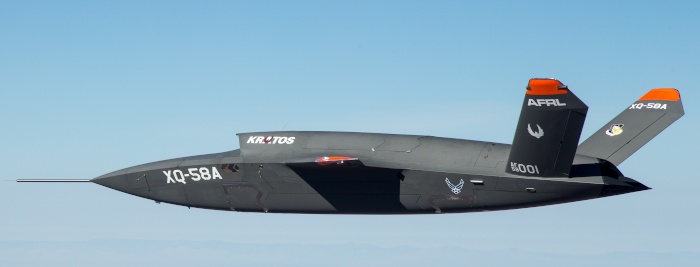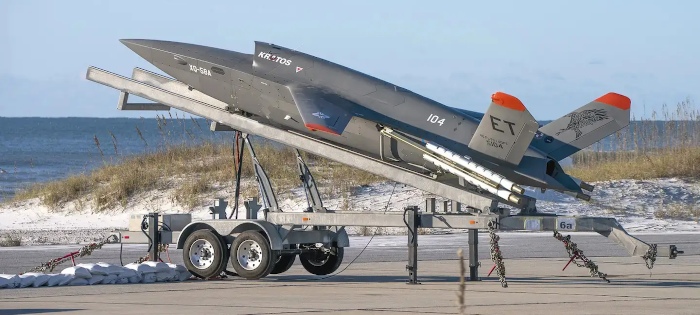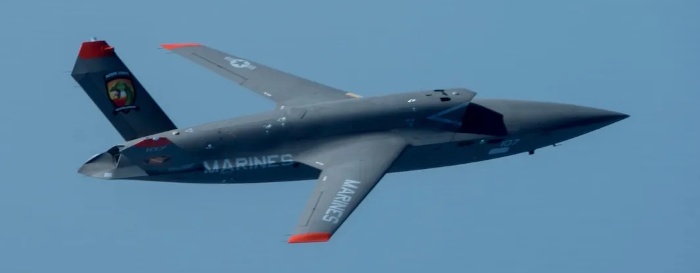Kratos XQ-58 Valkyrie
The XQ-58 Valkyrie is an experimental UCAV (Unmanned Combat Aerial Vehicle) testbed to test and evaluate various technonologies and tactics for future unmanned combat aircraft.
In 2016, the U.S. Air Force awarded Kratos a contract to design and build a demonstrator for the Air Force Research Lab's Low Cost Attritable Strike Demonstrator (LCASD) program. Kratos developed the XQ-222, a stealthy long-range multipurpose UAV, which in some respects went beyond what was specified for the LCASD requirement. Even so, the drone should still be relatively low-cost, to allow optionally expendable use of the vehicle. In 2017, the USAF designated the aircraft as XQ-58A Valkyrie. The first flight of the Valkyrie was conducted successfully in March 2019.
 |
| Photo: 88 Air Base Wing Public Affairs, USAF |
| XQ-58A |
The XQ-58A is launched from a trailer using solid-propellant rocket boosters, and recovered by parachute, thereby fulfulling the requirement of independence from runways. It is powered by a single turbofan engine, for high-subsonic speed and an operational range of about 5500 km (3500 miles). It can fly at altitudes between 15 m and 13700 m (50 ft and 45000 ft). Payload capacity is 270 kg (600 lb) each internally and on wing stations.
 |
| Photo: USAF |
| XQ-58A |
During its flight test program, the XQ-58A has successfully demonstrated its performance envelope, has released a smart munition from its internal payload bay, and has acted as a datalink relay between an F-35 and an F-22 fighter. The Valkyrie is also designed to act as a so-called "loyal wingman", a UCAV accompanying a manned fighter for tasks like scouting and countermeasures, and to provide additional defensive and offensive weapons options. In this role, it is used to test and evaluate technology needed for the USAF's future Collaborative Combat Aircraft (CCA), an unmanned component of the NGAD (Next Generation Air Dominance) program. In August 2023, an XQ-58A was successfully flown autonomously by an AI (Artificial Intelligence) software package, which had been developed under the USAF's Skyborg program.
The current XQ-58A vehicles are of "Block 2" configuration, which was first flown in 2022. There are indications, that Kratos is developing advanced and/or enlarged variants of the Valkyrie, possibly to fulfill upcoming requirements for a full-scale CCA.
 |
| Photo: Master Sgt. Tristan McIntire, 96th TW, 40th FTS, USAF |
| XQ-58A |
In 2022 and 2023, the U.S. Marine Corps and U.S. Navy each ordered two XQ-58A vehicles to evaluate operational possibilties of the optionally-expendable combat UAV. The Marines' XQ-58A successfully demonstrated Electronic Attack payloads and capabilities in flight tests, working together with F-35 fighters. The USMC plans to acquire operational Valkyrie systems designated MQ-58B for the SEAD (Suppression of Enemy Air Defenses) role under its Marine Air-Ground Task Force (MAGTF) Unmanned Aerial System (UAS) Expeditionary (MUX) Tactical Aircraft (TACAIR) program.
Designation Note: The designation XQ-58A is out of sequence in the Q-series. The number 58 was apparently taken from the X-series: The assignment of XQ-58A fell between those of X-57A and X-59A, and there is no X-58A. It is unclear, why the Valkyrie was designated XQ-58A instead of X-58A, because unmanned X-planes are quite common nowadays.
Specifications
Note: Data given by several sources show slight variations. Figures given below may therefore be inaccurate!
Data for XQ-58A:
| Length | 9.1 m (30 ft) |
| Wingspan | 8.2 m (27 ft) |
| Height | 2.5 m (8.3 ft) |
| Weight | Empty: 1130 kg (2500 lb) Max: 2720 kg (6000 lb) |
| Speed | Mach 0.85 |
| Ceiling | 13700 m (45000 ft) |
| Range | 5500 km (3500 miles) |
| Propulsion | 1 turbojet; 8.9 kN (2000 lb) |
Main Sources
[1] Wikipedia: Kratos XQ-58 Valkyrie
[2] Kratos Website
[3] Thomas Newdick: "Multiple"
New Versions Of The XQ-58 Valkyrie In The Works
Back to Directory of U.S. Military Rockets and Missiles, Appendix 2
Last Updated: 8 April 2024